Relatively simple plaster sheet ceilings have recently been deservedly taken by the leading position in the repair and reconstruction of the premises of various appointments. The main reason for such popularity is the impressive speed and quality of wall decoration and ceilings using GLC.
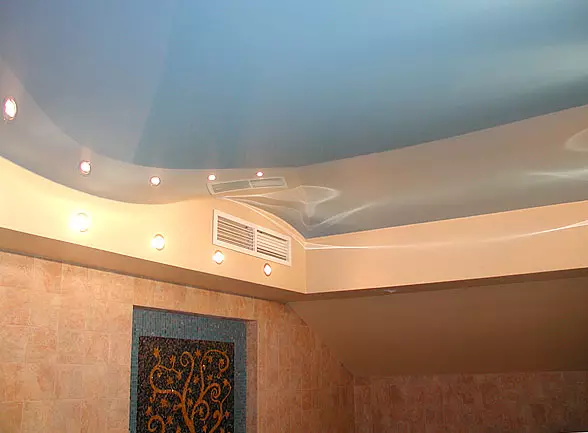
In the practice of repair and construction work, two main types of ceilings distinguish with drywall - single-level and multi-level.
In the practice of repair and construction work, two main types of ceilings mounted using drywall are single-level and multi-level. In this case, the advantages of the ceiling coating in one level applied to the materials and tools, as well as the procedure that will allow you to mount the perfectly even single-level ceiling of plasterboard with your own hands without the help of specialists from the side.
Advantages of drywall in comparison with plastering
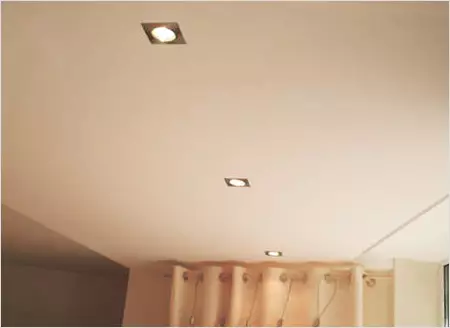
Plasterboard sheets make it possible to easily align the ceiling overlaps of almost any degree of curvature.
The famous long-term ceiling alignment technology with various plaster mixtures has proven itself in repair and construction work. However, only with the beginning of the production of plasterboard sheets, flawking even with the hands of experienced masters became obvious. To the pluses of the ceiling device using drywall are as follows:
- Plasterboard sheets make it possible to easily align the ceiling overlaps of almost any degree of curvature. At the same time, the ceiling can be applied with a layer of no more than 15 mm.
- Single-level plasterboard ceilings are able to effectively close various mounting structures, basic and additional communications, including wiring, ventilation and other pipes, various beams.
With the help of a hypospandine ceiling, you can improve your personal comfort with your own hands:
- In particular, you can arrange an additional heat and sound insulation of the room. In this case, the room will become more comfortable, and the irritating noise and sounds of loud music will not penetrate the neighbors.
- When installing a single-level ceiling from drywall, there is no "wet" stage inherent in the traditional plastering. Thus, plasterboard allows you to finish the ceiling device much faster, without a long drying of plaster.
Article on the topic: Right repair of plasterboard walls
Despite some disadvantages that have this technology (reducing the height of the room when installing the suspended plasterboard ceiling, possible cracks at the place of the sheets of sheets, the complexity of installation without helper), in general, single-level plasterboard ceilings are an excellent and simple option for who decide to do repair on your own. And he will help him in this knowledge of materials and tools used in this operation.
Materials and Tools for Plasterboard Ceilings
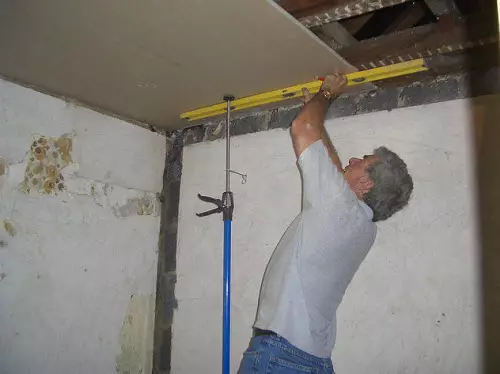
During the installation process, it is necessary to carefully monitor the smooth surface of the entire structure.
As a rule, the ceilings are cutting with standard plasterboard sheets. This building material has good insulating characteristics, very easy to handle tools. However, this advantage of plasterboard with improper storage and transportation is its significant disadvantage, and so that the sheets do not break during the installation, with them it is necessary to treat special care.
In accordance with the appointment and technical parameters, only five species of plasterboard sheets are distinguished - standard, moisture resistant, dry-fiber, fire-resistant and moisture-fire-resistant. In most cases, for mounting single-level ceilings, use standard and moisture-resistant plasterboard sheets.
For the device of such a ceiling, the following profiles and frames for the frame are necessary:
- main ceiling profile (PP);
- guide ceiling profile (PPN);
- direct suspension;
- Extension of the main profile;
- Crab type connector;
- Dowel-nails;
- Metal screws;
- Reinforced tape (with its help, seams are close between GLC).
Make a quality ceiling with your own hands, having the following set of tools:
- Perforator (shock drill);
- screwdriver;
- a hammer;
- pliers;
- Scissors for metal;
- nozzles for mixing the solution;
- drills on concrete and metal;
- Knife for plasterboard;
- Steel spatula.
Frame mounting work
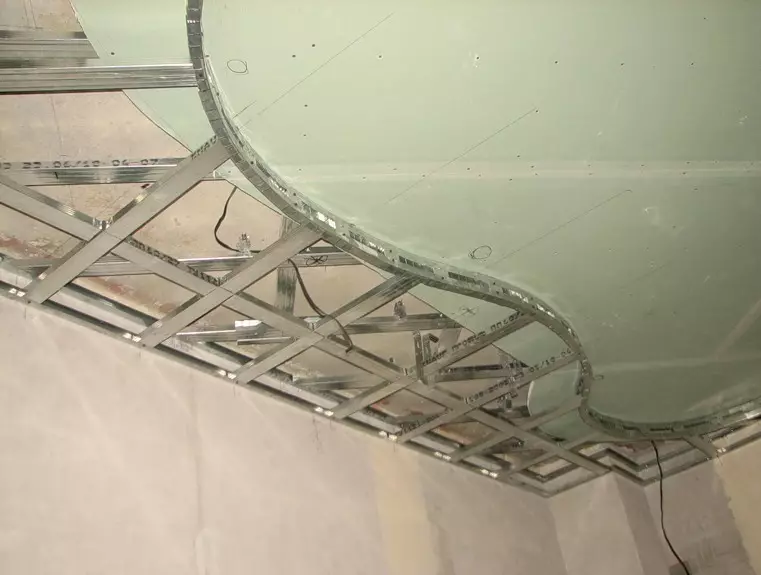
One of the important points of installation of the whole design is the installation of a frame.
Before starting to make a single-level ceiling with your own hands, you need to clean the main ceiling from the old putty or wallpaper. Be sure to remove all the lighting devices. Then around the perimeter of the room to hold the line at the prescribed distance from the ceiling. On this line will subsequently be attached to the guide and main profiles.
Article on the topic: What you need to know when creating a kitchen design - living room
The next step is to install on the ceiling of suspensions for mounting the main frame. This can be done in different ways, for example, by posting the entire ceiling area or apply a special mesh to the ceiling with an intersection in it for fastening of suspensions.
In this way, the points, approximately equal to the distance from each other, with the help of a perforator (shock drill) and a dowel with plastic sleeves are mounted. For single-level ceilings whose thickness does not exceed 100-120 mm, P-shaped suspensions are used; For drywall ceiling structures, more than 120 mm thick, special rod suspensions are used.
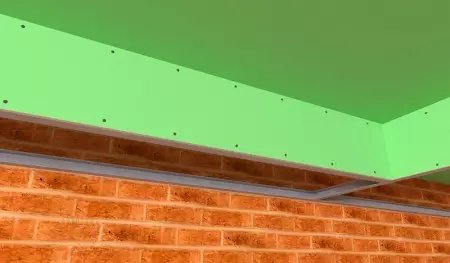
Single-level plasterboard ceilings are able to effectively close various mounting structures, including wiring, ventilation and other pipes.
After that, around the perimeter of the room on the walls on previously spent marks using a dowel-nail, a guide profile is attached (if there is a partner, then this operation can be made simultaneously with the fastening of the suspensions on the ceiling). As a result, a peculiar belt from the metal profile should be formed into which the main profile will be inserted.
Further establish the main profiles that will take on all the loads attached to them plasterboard sheets. The ends of the main profiles are hardened in the grooves of the guide profiles, along the entire length, these profiles are attached by self-pressing to the installed suspensions. All the time of installation you need to monitor that the basic support profiles do not begged. You can make it by mounting level.
In some cases, it may be necessary to use metal adapters - "crabs" or profile extensifiers. Thanks to these devices, you manage to make a single-level ceiling on a large area with your own hands.
Frame covering plasterboard sheets
Previously, it is necessary to cut the sheets of plasterboard in size so that they are on the ceiling in the fixed state are tight enough, without significant gaps, and fit together. Cutting must be made with a special knife using a ruler on the outlined lines. After cutting the upper, cardboard, the layer of the sheet must be carefully broken down. If nevertheless remains not very correct edges or edges of the cut parts will be not very smooth, they should be stuck with grater or sandpaper.
Article on the topic: Lighthouses for bulk sex do it yourself: installation order
The resulting whole sheets or their fragments are thoroughly glued or fasten with screw-related screws to the main profiles. This should be done with your assistants, if there are no assistants, it is necessary to fix the HCL using clamps. At the same time, it is necessary to monitor the screws with their caps to be completely recessed into a plasterboard sheet.
At the end of the installation of the plasterboard ceiling, it is necessary to make the finishing alignment of the resulting surface. For this, the seams are combined with a reinforced ribbon and filled with fresh putty. At the same time, you can not forget to miss the putty and recessed hats of self-tapping screws. Thus, a plasterboard single-level ceiling is ready for final finish.
